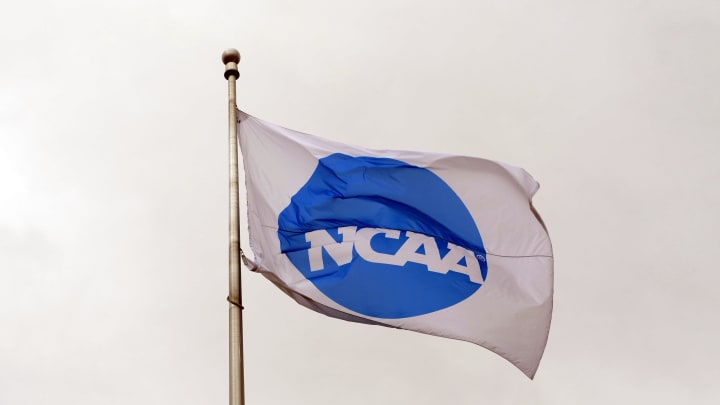NCAA under siege after latest NIL lawsuit filed by 1983 NC State championship team

In this story:
The shot of the late Jim Valvano frantically running around The Pit looking for someone to embrace after the 1983 national championship game has become an iconic moment in NCAA Tournament lore.
The Wolfpack became known as the “Cardiac Pack” following a run of six thrilling NCAA Tournament games, capped off by a buzzer-beating dunk from Lorenzo Charles to knock off Houston, 54-52, in the title game. The shot and ensuing chaos have become a fixture of March Madness television coverage over the last 31 years.
Now, members of North Carolina State’s 1983 national championship team have sued the NCAA and the Collegiate Licensing Company for unauthorized use of their name, image and likeness, regarding the game and the shot. Ten players filed in Wake County Superior Court on Monday and requested a jury trial and “reasonable compensation,” according to ESPN.
The suit contends that the value of student-athletes to the NCAA does not end with their graduation and that archival footage and other products “constitute an ongoing income stream” for the NCAA after its players moved on from college.
Once again, the NCAA finds itself in a legal battle over student-athlete compensation. If NC State’s suit sounds familiar, it's because the NCAA is already in the stages of paying current and former athletes from 2016-20 as part of a $2.8 billion agreement to settle three antitrust cases.
House v. NCAA sought backpay for Division-I athletes who were barred from earning NIL compensation prior to the NCAA changing its policy in the summer of 2021, which followed the U.S. Supreme Court’s decision to uphold NCAA v. Alston ruling that said the NCAA’s cap on education-related expenses was an antitrust violation. Then came lawsuits from multiple state attorneys general that barred the NCAA from enforcing its NIL regulations and rules regarding multi-time transfers.
The courts haven’t favored the NCAA when it comes to its treatment of student-athletes as of late. And if the lawsuit brought forward by the 1983 NC State team ends in another hefty price tag for the NCAA, who’s to say more student-athletes won’t seek backpay as well?
What about the 2014-15 Kentucky Wildcats? A team that went 38-1 with nine NBA players on the roster, including Devin Booker and Karl-Anthony Towns, would’ve surely capitalized in the NIL space. Some people actually thought that team could’ve beaten the Philadelphia 76ers, which is a testament to how good the Wildcats were that season.
Mario Chalmers’ miraculous game-tying shot over Derrick Rose in the 2008 national championship is another iconic moment that’s often replayed during NCAA Tournament coverage — as is Trey Burke’s game-tying 3-pointer against the Jayhawks in the 2013 Sweet 16, RJ Hunter’s deep triple to lead 14-seed Georgia State past 3-seed Baylor in 2015 and Paul Jespersen’s halfcourt buzzer-beat against Texas in 2016, to name a few.
Cinderella stories like Doug Edert and Saint Peter’s in 2022, Sister Jean and Loyola Chicago in 2018 and the “Lob City” Florida Gulf Coast team from 2015 are part of what makes the NCAA Tournament unique from other sporting events. They’re also a big reason why the tournament is so popular from a viewership standpoint.
So what’s stopping other memorable athletes and teams like the 1983 NC State squad from seeking their fair share from the NCAA? And based on the outcomes of previous antitrust cases, can the NCAA hold its ground in any potential future trials? There’s a lot at stake for the governing body and college sports.

Cole Forsman is a reporter for Gonzaga Bulldogs On SI. Cole holds a degree in Journalism and Sports Management from Gonzaga University.
Follow CGForsman